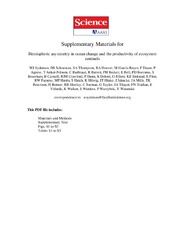Blar i forfatter Norges arktiske universitetsmuseum "Erikstad, Kjell E."
-
Circumpolar dynamics of a marine top-predator track ocean warming rates.
Descamps, Sebastian; Anker-Nilssen, Tycho; Barrett, Robert T.; Irons, D.; Merkel, Flemming; Robertson, Gregory J.; Yoccoz, Nigel Gilles; Mallory, Mark L.; Montevecchi, William A.; Boertmann, D.; Artukhin, Yuri; Christensen-Dalsgaard, Signe; Erikstad, Kjell E.; Gilchrist, H. Grant; Labansen, Aili; Lorentsen, Svein Håkon; Mosbech, Anders; Olsen, Bergur; Petersen, Aevar; Rail, Jean-Francois; Renner, Heather M.; Strøm, H.; Systad, Geir Helge; Wilhelm, Sabina I.; Zelenskaya, Larisa (Journal article; Tidsskriftartikkel; Peer reviewed, 2017-04-07)Global warming is a nonlinear process, and temperature may increase in a stepwise manner. Periods of abrupt warming can trigger persistent changes in the state of ecosystems, also called regime shifts. The responses of organisms to abrupt warming and associated regime shifts can be unlike responses to periods of slow or moderate change. Understanding of nonlinearity in the biological responses to ... -
Climate-Driven Ichthyoplankton Drift Model Predicts Growth of Top Predator Young
Myksvoll, Mari Skuggedal; Erikstad, Kjell E.; Barrett, Robert T.; Sandvik, Hanno; Vikebø, Frode Bendiksen (Journal article; Tidsskriftartikkel; Peer reviewed, 2013-11-12)Climate variability influences seabird population dynamics in several ways including access to prey near colonies during the critical chick-rearing period. This study addresses breeding success in a Barents Sea colony of common guillemots Uria aalge where trophic conditions vary according to changes in the northward transport of warm Atlantic Water. A drift model was used to simulate interannual ... -
Hemispheric asymmetry in ocean change and the productivity of ecosystem sentinels
Sydeman, William J.; Schoeman, David S.; Thompson, Sarah Ann; Hoover, Brian A.; García-Reyes, Marisol; Daunt, Francis; Agnew, Philippa; Anker-Nilssen, Tycho; Barbraud, Christophe; Barrett, Robert; Becker, Peter H.; Bell, Elisabeth; Boersma, P. Dee; Bouwhuis, Sandra; Cannell, Belinda; Crawford, Robert J. M.; Dann, Peter; Delord, Karine; Elliot, Graeme; Erikstad, Kjell E.; Flint, Elizabeth; Furness, Robert W.; Harris, Michael P.; Hatch, Scott; Hilwig, Kara; Hinke, Jefferson T.; Jahncke, Jaime; Mills, James A.; Reiertsen, Tone Kristin; Renner, Heather; Sherley, Richard B.; Surman, Christopher; Taylor, Graeme; Thayer, Julie A.; Trathan, Phil N.; Velarde, Enriqueta; Walker, Kath; Wanless, Sarah; Warzybok, Pete; Watanuki, Yutaka (Journal article; Tidsskriftartikkel; Peer reviewed, 2021-05-28)Climate change and other human activities are causing profound effects on marine ecosystem productivity. We show that the breeding success of seabirds is tracking hemispheric differences in ocean warming and human impacts, with the strongest effects on fish-eating, surface-foraging species in the north. Hemispheric asymmetry suggests the need for ocean management at hemispheric scales. For the north, ... -
Ocean climate and egg investment in the black-legged kittiwake Rissa tridactyla.
Barrett, Robert T.; Erikstad, Kjell E.; Reiertsen, Tone (Journal article; Tidsskriftartikkel; Peer reviewed, 2017-09-14)Birds allocate substantial resources to their eggs during the laying period, resources also needed for other concurrent costly processes such as mate acquisition, nest building and site defence. Egg and clutch sizes may thus vary in response to food availability prior to egg laying. We investigated the variation in egg and clutch size of black-legged kittiwakes Rissa tridactyla in a North Norwegian ... -
Prey density in non-breeding areas affects adult survival of black-legged kittiwakes Rissa tridactyla
Reiertsen, Tone K.; Erikstad, Kjell E.; Anker-Nilssen, Tycho; Barrett, Robert T.; Boulinier, Thierry; Frederiksen, Morten; González-Solís, Jacob; Grémillet, David; Johns, David; Moe, Børge; Ponchon, Aurore; Skern-Mauritzen, Mette; Sandvik, Hanno; Yoccoz, Nigel Gilles (Journal article; Tidsskriftartikkel; Peer reviewed, 2014-08-27)In migratory birds, environmental conditions in both breeding and non-breeding areas may affect adult survival rates and hence be significant drivers of demographic processes. In seabirds, poor knowledge of their true distribution outside the breeding season, however, has severely limited such studies. This study explored how annual adult survival rates of black-legged kittiwakes Rissa tridactyla ... -
The stress hormone corticosterone in a marine top predator reflects short-term changes in food availability
Barrett, Robert T.; Erikstad, Kjell E.; Sandvik, Hanno; Myksvoll, Mari Skuggedal; Jenni-Eiermann, Susi; Kristensen, Ditte Lyngbo; Moum, Truls; Reiertsen, Tone; Vikebø, Frode Bendiksen (Journal article; Tidsskriftartikkel; Peer reviewed, 2015)In many seabird studies, single annual proxies of prey abundance have been used to explain variability in breeding performance, but much more important is probably the timing of prey availability relative to the breeding season when energy demand is at a maximum. Until now, intraseasonal variation in prey availability has been difficult to quantify in seabirds. Using a state-of-the-art ocean ... -
There is more to climate than the North Atlantic Oscillation: a new perspective from climate dynamics to explain the variability in population growth rates of a long-lived seabird
Mesquita, Michel d. S.; Erikstad, Kjell E.; Sandvik, Hanno; Reiertsen, Tone; Barrett, Robert T.; Anker-Nilssen, Tycho; Hodges, Kevin I.; Bader, Jürgen (Journal article; Tidsskriftartikkel; Peer reviewed, 2015-04-29)Predicting the impact of global climate change on the biosphere has become one of the most important efforts in ecology. Ecosystems worldwide are changing rapidly as a consequence of global warming, yet our understanding of the consequences of these changes on populations is limited. The North Atlantic Oscillation (NAO) has been used as a proxy for “climate” in several ecological studies, but this ... -
Twilight foraging enables European shags to survive the winter across their latitudinal range
Moe, Børge; Daunt, Francis; Bråthen, Vegard Sandøy; Barrett, Robert; Ballesteros, Manuel; Bjørnstad, Oskar; Bogdanova, Maria I.; Dehnhard, Nina; Erikstad, Kjell E.; Follestad, Arne; Gíslason, Sindri; Hallgrimsson, Gunnar Thor; Lorentsen, Svein-Håkon; Newell, Mark; Petersen, Aevar; Phillips, Richard A.; Ragnarsdóttir, Sunna Björk; Reiertsen, Tone Kristin; Åström, Jens; Wanless, Sarah; Anker-Nilssen, Tycho (Journal article; Tidsskriftartikkel; Peer reviewed, 2021-10-14)Species breeding at high latitudes face a significant challenge of surviving the winter. Such conditions are particularly severe for diurnal marine endotherms such as seabirds. A critical question is therefore what behavioural strategies such species adopt to maximise survival probability. We tested 3 hypotheses: (1) they migrate to lower latitudes to exploit longer day length (‘sun-chasing’), (2) ...


 English
English norsk
norsk






